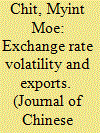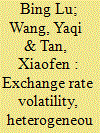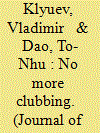| Srl | Item |
| 1 |
ID:
082896


|
|
|
|
|
| Publication |
2008.
|
| Summary/Abstract |
This paper examines the impact of exchange rate volatility on the bilateral exports within the ASEAN-China Free Trade Area (ACFTA) by using a generalized gravity model. A panel data set of 20 bilateral observations for the period from 1982:Q1 to 2005:Q1 is estimated using fixed-effect and random effect methods. Panel unit-roots and panel cointegration tests confirm the long-run relationship among the variables. The empirical results suggest that bilateral real exchange rate volatility has a statistically significant negative impact on the bilateral exports of the major ACFTA countries. But the magnitude of the impact appears to be fairly small
|
|
|
|
|
|
|
|
|
|
|
|
|
|
|
|
| 2 |
ID:
173747


|
|
|
|
|
| Summary/Abstract |
With the gradual promotion of market‐oriented reform of the RMB exchange rate, the fluctuation range of the RMB exchange rate is increasing. How to deal with the impact of exchange rate volatility on Chinese exports is an important challenge faced by China. This paper finds that although exchange rate volatility, as a whole, has a negative impact on exports, high‐productivity exporters are less prone to exchange rate volatility shock in both intensive and extensive margins. As high‐productivity firms are less affected by exchange rate risk, they account for larger market shares. This paper, from a new perspective, provides evidence that increasing productivity helps mitigate the negative impact of exchange volatility on exports.
|
|
|
|
|
|
|
|
|
|
|
|
|
|
|
|
| 3 |
ID:
154531


|
|
|
|
|
| Summary/Abstract |
This paper examines exchange rate behaviour in the ASEAN-5 countries (Indonesia, Malaysia, the Philippines, Singapore, and Thailand). It finds that for the last ten years, there is no evidence that their central banks target particular exchange rate levels against any currency or basket. Thus, contrary to some assertions, they do not belong to a dollar club, a yen club, a renminbi club, or an ASEAN club. At the same time, they clearly try to smooth short-term volatility, particularly vis-à-vis the U.S. dollar. The degree of smoothing declined noticeably after the Asian Financial Crisis and less obviously after the Global Financial Crisis, with heterogeneity across countries. Short-term smoothing without level targeting does not interfere with monetary policies aimed at price stability.
|
|
|
|
|
|
|
|
|
|
|
|
|
|
|
|